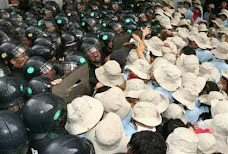
Saturday, May. 10, 2008
Is It Time to Invade Burma?
By Romesh Ratnesar
The disaster in Burma presents the world with perhaps its most serious humanitarian crisis since the 2004 Asian tsunami. By most reliable estimates, close to 100,000 people are dead. Delays in delivering relief to the victims, the inaccessibility of the stricken areas and the poor state of Burma's infrastructure and health systems mean that number is sure to rise. With as many as 1 million people still at risk, it is conceivable that the death toll will, within days, approach that of the entire number of civilians killed in the genocide in Darfur.
So what is the world doing about it? Not much. The military regime that runs Burma initially signaled it would accept outside relief, but has imposed so many conditions on those who would actually deliver it that barely a trickle has made it through. Aid workers have been held at airports. U.N. food shipments have been seized. U.S. naval ships packed with food and medicine idle in the Gulf of Thailand, waiting for an all-clear that may never come.
Burma's rulers have relented slightly, agreeing Friday to let in supplies and perhaps even some foreign relief workers. The government says it will allow a US C-130 transport plane to land inside Burma Monday. But it's hard to imagine a regime this insular and paranoid accepting robust aid from the U.S. military, let alone agreeing to the presence of U.S. Marines on Burmese soil — as Thailand and Indonesia did after the tsunami. The trouble is that the Burmese haven't shown the ability or willingness to deploy the kind of assets needed to deal with a calamity of this scale — and the longer Burma resists offers of help, the more likely it is that the disaster will devolve beyond anyone's control. "We're in 2008, not 1908," says Jan Egeland, the former U.N. emergency relief coordinator. "A lot is at stake here. If we let them get away with murder we may set a very dangerous precedent."
That's why it's time to consider a more serious option: invading Burma. Some observers, including former USAID director Andrew Natsios, have called on the U.S. to unilaterally begin air drops to the Burmese people regardless of what the junta says. The Bush Administration has so far rejected the idea — "I can't imagine us going in without the permission of the Myanmar government," Defense Secretary Robert Gates said Thursday — but it's not without precedent: as Natsios pointed out to the Wall Street Journal, the U.S. has facilitated the delivery of humanitarian aid without the host government's consent in places like Bosnia and Sudan.
A coercive humanitarian intervention would be complicated and costly. During the 2004 tsunami, some 24 U.S. ships and 16,000 troops were deployed in countries across the region; the mission cost the U.S. $5 million a day. Ultimately, the U.S. pledged nearly $900 million to tsunami relief. (By contrast, it has offered just $3.25 million to Burma.) But the risks would be greater this time: the Burmese government's xenophobia and insecurity make them prone to view U.S. troops — or worse, foreign relief workers — as hostile forces. (Remember Black Hawk Down?) Even if the U.S. and its allies made clear that their actions were strictly for humanitarian purposes, it's unlikely the junta would believe them. "You have to think it through — do you want to secure an area of the country by military force? What kinds of potential security risks would that create?" says Egelend. "I can't imagine any humanitarian organization wanting to shoot their way in with food."
So what other options exist? Retired General William Nash of the Council on Foreign Relations says the U.S. should first pressure China to use its influence over the junta to get them to open up and then supply support to the Thai and Indonesian militaries to carry out relief missions. "We can pay for it — we can provide repair parts to the Indonesians so they can get their Air Force up. We can lend the them two C-130s and let them paint the Indonesian flag on them," Nash says. "We have to get the stuff to people who can deliver it and who the Burmese government will accept, even if takes an extra day or two and even if it's not as efficient as the good old U.S. military." Egeland advocates that the U.N. Security Council take punitive steps short of war, such as freezing the regime's assets and issuing warrants for the arrest of individual junta members if they were to leave the country. Similar measures succeeded in getting the government of Ivory Coast to let in foreign relief teams in 2002, Egelend says.
And if that fails? "It's important for the rulers to know the world has other options," Egeland says. "If there were, say, the threat of a cholera epidemic that could claim hundreds of thousands of lives and the government was incapable of preventing it, then maybe yes — you would intervene unilaterally." But by then, it could be too late. The cold truth is that states rarely undertake military action unless their national interests are at stake; and the world has yet to reach a consensus about when, and under what circumstances, coercive interventions in the name of averting humanitarian disasters are permissible. As the response to the 2004 tsunami proved, the world's capacity for mercy is limitless. But we still haven't figured out when to give war a chance.
Find this article at:
http://www.time.com/time/world/article/0,8599,1739053,00.html































No hay comentarios:
Publicar un comentario